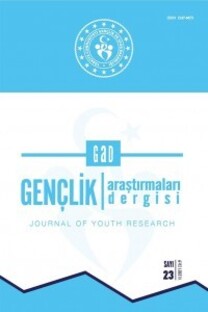Lise ve Üniversite Öğrencilerinin Gözünden “Üniversite”: Bir Metafor Çalışması
Üniversite, Metafor, Lise, Eğitim
Universities in the Eyes of High School and University Students: Using Metaphors to Describe Universities
University, Metaphor, High School, Education,
___
- Altun, Z. D., & Uzuner, F. G. (2017). Güzel sanatlar lisesi öğrencilerinin üniversite kavramına yönelik metaforik algıları. Eğitim ve İnsani Bilimler Dergisi: Teori ve Uygulama, 8(16), 60-83.
- Argon, T. (2015). Üniversite kavramına yönelik algıların metaforlarla boylamsal olarak incelenmesi: Türkiye'den bir üniversite örneği. Eğitim Araştırmaları ve İncelemeleri, 10(1), 36-49.
- Cameron, L. (1996). Discourse context and the development of metaphor in children. Current Issues in Language & Society, 3(1), 49-64.
- Charle, C., & Verger, J. (1994). Histoire des universités (Vol. 391). Presses universitaires de France.
- Christensen, L. B., Johnson, B., & Turner, L. A. (2014). Research methods, design, and analysis. New Jersey, USA: Pearson.
- Creswell, J. W., & Poth, C. N. (2016). Qualitative inquiry and research design: Choosing among five approaches. California: Sage publications.
- Demirtaş, H., & Çoban, D. (2014). Üniversite öğrencilerinin, üniversite ve fakülte kavramlarına ilişkin metaforları (İnönü Üniversitesi Örneği). Ondokuz Mayis University Journal of Education, 33(1), 113-143.
- Ertem, Z. S., & Ari, A. (2016). Lise öğrencilerinin üniversite ve ögretim elemani kavram algıları. Cumhuriyet International Journal of Education, 5(3), 78-92.
- Erdem, A. R. (2013). Bilgi toplumunda üniversitenin değişen rolleri ve görevleri. Yükseköğretim Dergisi, 3(2), 109-120.
- Erikson, E. (1964). Insight and Responsibility: Lectures on the ethical implications of psychoanalytic insight. New York, NY: W. W. Norton & Company.
- Etzkowitz, H. (2001). The bi-evolution of the university in the triple helix era. Science Policy Institute.
- Griffiths, D. E. (1965). Behavioural science and educational administration. Chicago: Chicago Press.
- Hamlyn, D. W. (1996). The concept of a university. Philosophy, 71(276), 205-218.
- Jorgensen‐Earp, C. R., & Staton, A. Q. (1993). Student metaphors for the college freshman experience. Communication Education, 42(2), 123-141.
- Kahu, E. R., & Picton, C. (2020). Using photo elicitation to understand first-year student experiences: Student metaphors of life, university and learning. Active Learning in Higher Education,1-13. https://doi.org/10.1177/1469787420908384
- Korkmaz, F., & Bağçeci, B. (2013). Lise öğrencilerinin ''Üniversite'' kavramına ilişkin metaforik algıların incelemesi. Bartın Üniversitesi Eğitim Fakültesi Dergisi, 2(1), 187-204.
- Kövecses, Z. (2017). Conceptual metaphor theory. In: Semino E and Demjén Z (Eds.) The Routledge Handbook of Metaphor and Language. London, United Kingdom: Routledge, 13- 27.
- Kövecses, Z., & Benczes, R. (2010). Metaphor: A practical ıntroduction, Oxford, United Kingdom: Oxford University Press.
- Lakoff, G., & Johnson, M. (1980). Metaphors we live by. Chicago: University of Chicago Press.
- Lakoff, G. (2006). Conceptual metaphor. Cognitive Linguistics: Basic Readings. Berlin, 185-239.
- Landau, M. J., Oyserman, D., Keefer, L. A., & Smith, G. C. (2014). The college journey and academic engagement: How metaphor use enhances identity-based motivation. Journal of Personality and Social Psychology, 106(5), 679.
- McGregor, S., & Volckmann, R. (2010). Transdisciplinarity in higher education: The path of Arizona State University. Integral Leadership Review, 10(3), 1-25.
- Merriam, S. B. (2009). Qualitative research: A guide to design and implementation. New Jersey, USA: John Wiley & Sons.
- Miles, M. B. & Huberman, A. M. (1994). Qualitative data analysis. (2nd edition). Thousand Oaks: Sage.
- Moser, K. S. (2000). Metaphor analysis in psychology: method, theory, and fields of application. Forum: Qualitative Social Research [On-line journal], 1(2). Available from http://www.qualitative-research.net/fqs-texte/2-00/2-00moser-e.htm.
- Oyman, N., & Şentürk, İ. (2015). Öğretmen adayları ve öğretim üyelerinin “üniversite” kavramına ilişkin metaforik algıları. Kuram ve Uygulamada Eğitim Yönetimi Dergisi, 21(3), 367-394.
- Radmard, S., & Soysal, Y. (2019). Eğitim fakültesinin çeşitli öğretim programlarındaki öğretmen adaylarının üniversite kavramına ilişkin metaforik akıl yürütmeleri. Journal of Higher Education & Science, 9(3), 1-18.
- Rasmussen, E., Moen, Ø., & Gulbrandsen, M. (2006). Initiatives to promote commercialization of university knowledge. Technovation, 26(4), 518-533.
- Rothman, S., Kelly-Woessner, A., & Woessner, M. (2010). The still divided academy: How competing visions of power, politics, and diversity complicate the mission of higher education. Rowman & Littlefield Publishers.
- Toylan, N. V., & Göktepe, E. A. (2010). Öğrenen organizasyon olarak üniversiteler: Türkiye’deki bir devlet üniversitesinde durum analizi. Sosyal ve Beşeri Bilimler Dergisi, 2(1), 61-68.
- Taylor, J., & Miroiu, A. (2002). Policy Making, Strategic Planning and Management of Higher Education. Philadelphia: Carfax Publishing, Taylor & Francis Ltd.
- Yang, T. P., & Liu, A. S. (2009). The analysis of university metaphors. University Education Science, 3, 30-34.
- ISSN: 2147-8473
- Yayın Aralığı: 3
- Başlangıç: 2012
- Yayıncı: T.C. Gençlik ve Spor Bakanlığı Eğitim, Kültür ve Araştırma genel Müdürlüğü
Emrah SERDAR, Duygu HARMANDAR DEMİREL
Erasmus+ Vasıtasıyla Öğrenen Örgütü Teşvik Etmek: Türkiye’de Gençlik Kuruluşları
Lise ve Üniversite Öğrencilerinin Gözünden “Üniversite”: Bir Metafor Çalışması
Fatma ALTINSOY, Kübra KARAKAYA ÖZYER
Ergenlerde Öfke, Duygusal Zekâ ve Öz Duyarlılık Arasındaki İlişkinin İncelenmesi
